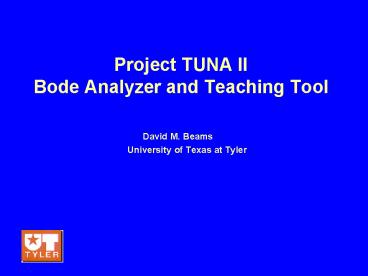Project TUNA II Bode Analyzer and Teaching Tool - PowerPoint PPT Presentation
1 / 16
Title:
Project TUNA II Bode Analyzer and Teaching Tool
Description:
Etymology: Middle English, from Late Latin taediosus, from Latin taedium ... GPIB-based laboratory instruments (Agilent E3631A Power Supply, HP33120 ... – PowerPoint PPT presentation
Number of Views:52
Avg rating:3.0/5.0
Title: Project TUNA II Bode Analyzer and Teaching Tool
1
Project TUNA IIBode Analyzer and Teaching Tool
- David M. Beams
- University of Texas at Tyler
2
BackgroundProject TUNA
- Dictionary definition of tedious
- Etymology Middle English, from Late Latin
taediosus, from Latin taedium1 tiresome because
of length or dullness BORING lta tedious public
ceremonygt - 2 manual frequency-response measurements-
tediously adverb- tediousness noun - With apologies to the Merriam-Webster On-line
Dictionary
3
Development of Project TUNA
- Developed as class project in Electronics II in
1999 six permanent copies made in 2000. - Combined GPIB-based laboratory instruments
(Agilent E3631A Power Supply, HP33120 Arbitrary
Waveform Generator, HP34401A Digital Multimeter)
with a LabVIEW virtual instrument (VI) and custom
external hardware. - Used successfully in measuring frequency response
in Electronics I and II Laboratory procedures. - Upgraded VI with capability to write to
spreadsheet file for graphing.
4
Structure of Project TUNA instrument
5
Structure of Project TUNA Hardware
6
Structure of Project TUNA Hardware
- Quadrature networks analog all-pass networks
that produce quadrature output signals over a
wide range of frequencies (251) designed by the
process described by Keely 1
1 Keely, T. A. Design of constant phase
difference networks. RF Design 12 (4), pp. 32,
37, 38, 40, 42 (April, 1989).
7
Operation of Project TUNA
- Determination of network voltage gain from
measured dc outputs of switching-type
phase-sensitive demodulator
8
Experience with Project TUNA
- Successful in laboratory students reported
significant time savings in making
frequency-response measurements - Allowed introduction of advanced topic
(phase-sensitive demodulation) into curriculum - Maximal operating frequency did not achieve
expectations due to charge injection in the
ADG201HS high-speed analog switches - Analysis time longer than necessary due to
fixed-bandwidth low-pass filters - Required major investment in GPIB-based
instrumentation
- Somewhat limited dynamic range (30dB to -30dB)
9
Genesis of Project TUNA II
- Measurement frequency to 1MHz
- Shorter analysis times
- Greater dynamic range (40dB to -40dB)
- Reduced reliance on GPIB-based instrumentation
- Use of multifunction I/O card to perform analog
input and digital output function - Work begun in 2001 as a senior project by Zinnour
Soultanov permanent hardware and revised VI
created in 2004
10
Project TUNA II vs. Project TUNA
- Multiplying (instead of switching)
phase-sensitive demodulator - Attenuator to adjust voltage applied to network
under test over a range of 10001 - Selectable time-constant low-pass filters to
shorten analysis times at frequencies greater
than 200Hz - Amplifier with selectable voltage gain (1 or 10)
- Data-acquisition card measures dc output voltages
VOI and VOQ simultaneously instead of
sequentially - Digital outputs of data-acquisition card control
the attenuator, In/Out Relay, amplifier gain, and
low-pass filter time constant - Fourth quadrature network (utilizing two poles
per channel instead of four) covering the
frequencies from 100kHz to 1MHz
- Requires only one GPIB test instrument (HP 33120A
arbitrary waveform generator).
11
Structure of Project TUNA II
12
Implementation of Project TUNA II
13
Project TUNA II Virtual Instrument Panel
14
Project TUNA II Performance
Bandpass filter Center frequency1kHz Q10,
AV20dB TUNA 6 m 24s TUNA II 1 m 10s
15
Project TUNA II Performance
Series RCL network Series resonant frequency
229kHz
TUNA II analysis time 46s Matches PSPice
results within 1dB and 4 from 30kHz to 300kHz
16
Project TUNA II Instructional Use and Resources
- Instructional use
- Used in Electronics I and Electronics II as
laboratory instrument - Used in EENG 4302 (Measurement and
Instrumentation Systems) to explain
phase-sensitive demodulation - Quadrature networks discussed in connection with
active filters - Resources
- LabVIEW VI
- Tutorial on phase-sensitive demodulation
- Schematics and documentation
- Spreadsheet for design of quadrature networks
- Printed circuit board artwork







![Modeling MEMS Sensors [SUGAR: A Computer Aided Design Tool for MEMS ] PowerPoint PPT Presentation](https://s3.amazonaws.com/images.powershow.com/4532729.th0.jpg?_=20200927124)























